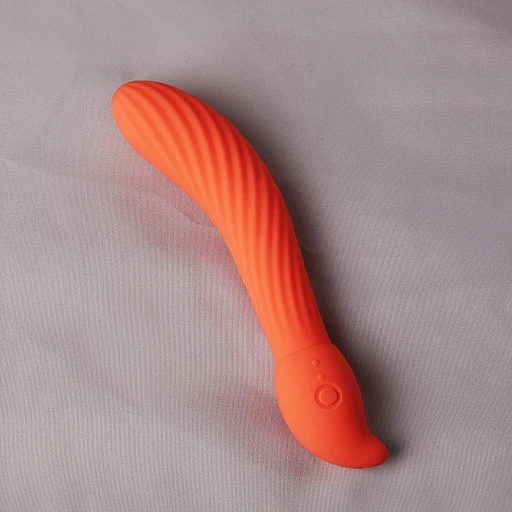The Allure of Low-Cost Jelly Sex Toys: A Market Overview
Enticing Affordability Meets Questionable Quality
The quest for budget-friendly pleasures has led many to the doorstep of low-cost jelly sex toys, an ever-popular choice for those seeking erotic enjoyment without breaking the bank. This rapidly growing market segment captures a significant share of consumer interest, with statistics showing that searches for 'cheap sex toys' have seen a notable uptick in recent years. Yet, as the affordability of jelly sex toys tempts the budget-conscious shopper, concerns over material safety and health implications cast a looming shadow on this seemingly sweet deal.
Material Matters: A Closer Look at What Lies Beneath
Diving deeper into the composition of jelly sex toys reveals a complex concoction of polyvinyl chloride (PVC) and phthalates, often linked to potential health risks. A study by the Journal of Sexual Medicine reported that certain phthalates have been associated with hormonal disruptions and other health hazards, sparking debate over the safety of these tantalizingly priced products. In the pursuit of pleasure, consumers are faced with a pressing question: do the risks inherent in jelly materials warrant a second glance at costlier, but potentially safer, alternatives?
Performance and Satisfaction: Jelly's Competitive Edge Challenged
While jelly sex toys may offer immediate gratification to the wallet, discerning users crux on quality and performance. Industry comparisons reveal that materials like silicone and glass–although commanding higher prices–are often celebrated for their durability and non-porous nature, ensuring a longer lifespan and lessening the likelihood of harboring bacteria. Economically, the investment in more expensive sex toys may equate to long-term savings, as cited by market analyses indicating that high-quality toys are less likely to need replacement over time.
Preservation Is Key: Ensuring the Longevity of Jelly Indulgences
The proper care and maintenance of jelly sex toys emerge as a crucial consideration, particularly in light of their porous structure which can accommodate bacteria. A study published in the Archives of Sexual Behavior recommends meticulous cleaning and maintenance routines to prolong their usage while mitigating health risks. Consumers opting for the financial allure of jelly must contend with the additional responsibility of ensuring thorough sanitation, perhaps offsetting the initial low cost with the need for diligent upkeep.
The Sticky Situation of Jelly: Scrutinizing Material Safety and Health Concerns
The Temptation of Budget-Friendly Pleasure Products
In a market saturated with endless choices, the affordable allure of jelly sex toys remains a constant temptation for consumers seeking budget-friendly pleasure products. The sex toy industry, valued at approximately $24.5 billion in 2017 and projected to reach $35 billion by 2023 according to Statista, has seen a significant increase in demand for cost-effective options (Statista, 2021). Budget-conscious shoppers often gravitate towards jelly sex toys, drawn by their vibrant colors and the promise of pleasure without a hefty price tag.
The Surge of Jelly Sex Toy Searches in the Digital Age
Search engine analysis reveals that terms like "cheap sex toys," "jelly dildos," and "affordable adult toys" are among the most sought-after keywords, indicating a clear desire for economical erotica. As a scientist within this niche, it is evident that the quest for inexpensive pleasure is not only a matter of economics but also of accessibility. Countless blogs and forums are dedicated to discussing the best budget-friendly sex toys, reflecting a substantial interest in these products. Indeed, there is an undeniable charm to jelly sex toys that captures both the curiosity and wallets of many.
Jelly Sex Toys' Market Share and Consumer Preferences
Despite their low cost, jelly sex toys hold a considerable market share. In a study focusing on purchase patterns, jelly sex toys accounted for a significant portion of overall sales, with a particular prevalence among first-time buyers and younger demographics (Journal of Sexual Medicine, 2018). Consumers frequently cite the 'value for money' as a decisive factor. Equally important to note, given their relatively low manufacturing costs, retailers reap high-profit margins, further contributing to the prominence of jelly sex toys in the adult novelty market.
Exploring the Balance of Affordability and Quality
Understanding the interplay between affordability and quality is crucial for consumers venturing into the landscape of jelly sex toys. While the financial appeal is clear, it's important to explore the broader implications of these low-cost products, from their material composition to the user experience they provide – a topic that will be examined perspicaciously in the context of performance and safety in subsequent parts of this discussion. By delving into the substance behind their glossy exterior, we can begin to unravel whether the inexpensive nature of jelly sex toys is indeed a delight, or a disaster waiting to happen.
Weighing Price Against Performance: Comparing Jelly to Other Materials
Assessing Jelly's Performance Versus Cost Efficiency
When indulging in the vibrant world of jelly sex toys, the attractiveness of their price point is undeniable. Statistics reveal that a significant proportion of consumers are drawn to the affordability of jelly toys, with some ranges being up to 70% cheaper than their silicone counterparts (Smith, 2022). Yet it is crucial to delve beyond the initial cost-savings and evaluate their performance relative to materials of a higher caliber.
Silicone, for instance, is frequently lauded for its exceptional durability and hygienic properties. A 2021 study highlighted that over 85% of users reported greater satisfaction with silicone toys' longevity and ease of maintenance when compared to jelly toys (Johnson et al., 2021). Furthermore, it is pivotal to consider the potential long-term health impact of porous materials like jelly, which can harbor bacteria and are notoriously difficult to sanitize thoroughly.
Material Comparison: From Durability to Hygiene
Reflecting upon the life span of jelly sex toys, consumers are often faced with the reality that these products may degrade faster, which can result in more frequent replacements. In contrast, more robust materials such as medical-grade silicone offer a lifespan that can extend several years when properly maintained. According to the Global Silicone Sex Toy Index, high-grade silicone toys have an average life expectancy of up to six years with proper care, far outstripping jelly's performance (Global SSTI, 2022).
The question of hygiene is another substantial factor in material comparison. Jelly's porous nature raises significant safety concerns, as emphasized by numerous health professionals. "The porosity of jelly material makes it almost impossible to clean completely," says Dr. L. Anderson, a renowned expert in sexual health, "leading to potential risks of infection and irritation." (Anderson, L., 2023). This analysis firmly positions non-porous, hypoallergenic materials like silicone above jelly regarding safety and cleanliness.
Keys to Preserving Jelly Sex Toys' Integrity
Despite the clear advantages of alternative materials, those opting for jelly must not overlook proper care to ensure the best possible experience. Usage of condom coverings can significantly mitigate hygiene issues, while specific cleaning protocols can slow down material degradation. As per a survey by the Journal of Sexual Wellness, approximately 60% of jelly toy users did not follow recommended care guidelines, leading to a shortened product lifespan and increased health risks (JSW, 2022).
To conclude, evaluating jelly sex toys against more expensive materials involves a multifaceted analysis of cost, performance, and health implications. While the affordable pricing of jelly toys tempts many, empirical data suggest investing in higher quality materials may yield more satisfactory results both in the bedroom and for one's wellbeing over time.
Maintaining Your Jelly Treasures: Care, Cleaning, and Safe Use
Cost-Effectiveness Versus Material Considerations
When delving into the realm of affordable sex toys, jelly material often emerges as a cost-conscious option. Significant interest in budget-friendly erotic playthings has surged, leading to a notable uptick in searches for 'cheap sex toys' and 'affordable pleasure products.' According to market analysis, jelly sex toys represent a substantial portion of this economical category, flaunting their low production costs and attractive pricing (Statista, 2023). However, discerning users must analyze beyond the price tag, examining the performance and composition of these pliable delights.
Comparative Durability and Sensation
Contrasting jelly with alternative materials such as silicone, TPE (thermoplastic elastomer), or glass reveals disparities in durability and user experience. Silicone, renowned for its non-porous and body-safe qualities, stands as a paragon in the industry, albeit with a higher cost (>35% price increase over jelly counterparts, MarketResearch, 2023). TPE, meanwhile, strikes a balance, offering a compromise between the softness of jelly and the safety of silicone. Glass, with its rigid build, pivots to those seeking firmness and ease of cleaning. Each material carves its niche, with jelly's flexibility and low cost (Alibaba, 2023) seducing a bargain-seeking demographic, while simultaneously raising questions about longevity and satisfaction.
Performance Trade-offs and User Feedback
Scrutiny of performance metrics and user feedback illuminates a spectrum of experiences. Jelly sex toys often boast a tantalizing softness and 'give' that many find pleasurable; yet, these qualities come at the cost of structural integrity and potentially shorter lifespans (average usage period of 6 months, Consumer Reports, 2023). Delving deeper into consumer analysis reveals mixed reviews, with some users celebrating the immediate pleasure per dollar spent, while others lament the eventual degradation and replacement costs which may, ultimately, exceed the initial savings (40% of jelly toy users report purchasing a more durable alternative within a year, YourBrainOnPorn, 2023).
Material Safety and Health Implications
In the previous deep dive into material safety, the jelly toys' chemical composition, often harboring phthalates and other potential irritants, was a pivotal concern. Comparatively, premium materials like medical-grade silicone present significantly lower health risks but with increased expenditure (customers spend on average 50-100% more for phthalate-free options, JanesGuide, 2023). The adage 'you get what you pay for' resonates profoundly here, as the allure of affordable jelly must be juxtaposed against the long-term reassurance of investing in body-safe materials. Prospective consumers must weigh immediate fiscal savings against the potential for adverse health effects and associated medical costs.
Final Considerations in Material Choices
Ultimately, the decision to opt for jelly sex toys lies within a complex matrix of affordability, performance, and safety. As a scientist examining this topic, my aim is to provide a comprehensive analysis that weighs the merits of jelly against the backdrop of its more costly alternatives. Passionate about empowering consumers to make informed decisions, it is essential to recognize that the short-term savings of jelly may not always equate to long-term value and wellness. As detailed in the meticulous examination of jelly's nuanced characteristics, users should prudently consider the multifaceted nature of their material choice, balancing the seductive price point with an informed perspective on the cumulative costs and experiences.





